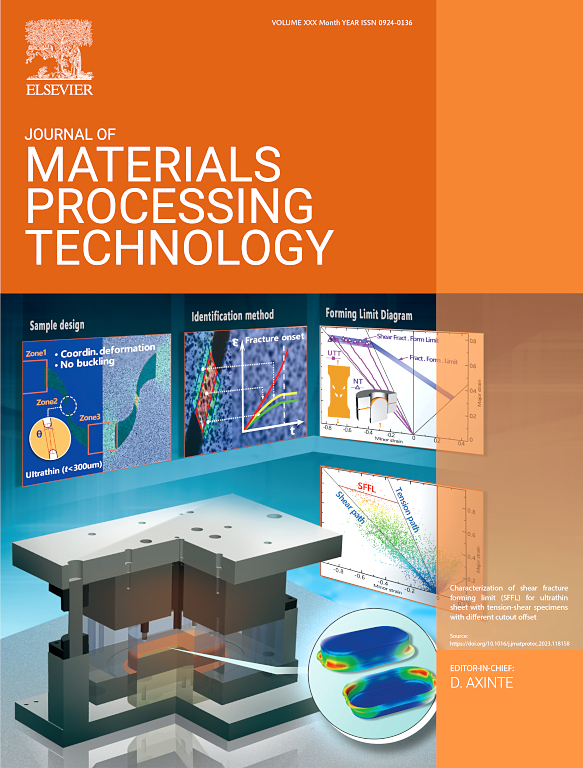Advanced laser directed energy deposition of Q690D high-strength steel using flux-cored wire: Microstructure evolution and mechanical performance
IF 7.5
2区 材料科学
Q1 ENGINEERING, INDUSTRIAL
Journal of Materials Processing Technology
Pub Date : 2025-08-19
DOI:10.1016/j.jmatprotec.2025.119029
引用次数: 0
Abstract
High humidity and corrosive marine environments present substantial challenges to the durability and repair of high-strength steels. In this study, a structurally sound and defect-free repair of offshore-grade Q690D high-strength low-alloy steel was successfully achieved using a combination of flux-cored wire and laser wire-directed energy deposition technology. The repaired region was predominantly composed of lath martensite in both the deposition zone and the heat-affected zone. During the deposition process, the flux-cored wire facilitated the in-situ formation of nanoscale Ti2C and TiC precipitates with core-shell structures through metallurgical reactions with the surrounding matrix. The repaired specimens exhibited a tensile strength of approximately 807 MPa, comparable to that of the base metal, along with a significantly enhanced flexural strength of ∼1626 MPa, primarily due to the synergistic interaction between nano-precipitates, lath martensite structures, and dislocation movement. However, Charpy impact energy at −20 ℃ decreased to approximately 52.4 % of the base material, owing to the embrittling effects of lath martensite and oxide inclusions, which facilitate void nucleation and crack propagation. These results validate the application potential of flux-cored wire assisted laser wire-directed energy deposition technology for repairing high-strength steels in marine-relevant environments, and reveal a coupled strengthening and embrittlement mechanism. This provides both mechanistic insight and practical guidance for the restoration of other structural alloys with similar service demands.
Q690D高强度钢药芯焊丝激光定向能沉积:组织演变与力学性能
高湿度和腐蚀性的海洋环境对高强度钢的耐久性和修复提出了重大挑战。在本研究中,采用药芯焊丝和激光焊丝定向能量沉积技术相结合的方法,成功地实现了海上级Q690D高强度低合金钢结构健全、无缺陷的修复。修复区在沉积区和热影响区均以板条马氏体为主。在沉积过程中,药芯焊丝通过与周围基体的冶金反应,有利于原位形成具有核壳结构的纳米级Ti2C和TiC相。修复后的试样的抗拉强度约为807 MPa,与母材相当,同时弯曲强度显著提高至~ 1626 MPa,这主要是由于纳米析出物、板条马氏体结构和位错运动之间的协同作用。而在- 20℃时,由于板条马氏体和氧化物夹杂的脆化作用,有利于空洞形核和裂纹扩展,夏比冲击能下降到基体的52.4 %左右。这些结果验证了药芯线辅助激光定向能沉积技术在海洋环境中修复高强钢的应用潜力,揭示了强化和脆化耦合机制。这为具有类似使用要求的其他结构合金的修复提供了力学见解和实践指导。
本文章由计算机程序翻译,如有差异,请以英文原文为准。
求助全文
约1分钟内获得全文
求助全文
来源期刊

Journal of Materials Processing Technology
工程技术-材料科学:综合
CiteScore
12.60
自引率
4.80%
发文量
403
审稿时长
29 days
期刊介绍:
The Journal of Materials Processing Technology covers the processing techniques used in manufacturing components from metals and other materials. The journal aims to publish full research papers of original, significant and rigorous work and so to contribute to increased production efficiency and improved component performance.
Areas of interest to the journal include:
• Casting, forming and machining
• Additive processing and joining technologies
• The evolution of material properties under the specific conditions met in manufacturing processes
• Surface engineering when it relates specifically to a manufacturing process
• Design and behavior of equipment and tools.
 求助内容:
求助内容: 应助结果提醒方式:
应助结果提醒方式:


